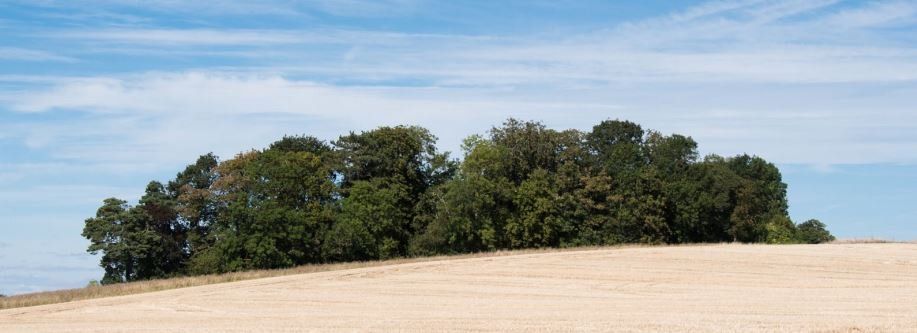The Big Green Internet Project
Ten years ago, Michel Wadham, the owner of The Big Green Internet Ltd was busily planting small woodlands, but as he was doing so an observation was gnawing away in his mind. As he looked around the landscape in the far east of Essex, he noticed that there were many woodlands sitting as islands in a sea of agriculture and not able to communicate with each other in an ecological sense.

What if a dormouse population became extinct in one woodland, how would it repopulate if there was no connection with other woods? If this extinction process occurred across the whole countryside it would be like an aeroplane falling apart one rivet at a time.
He thought, let’s continue to plant woodlands, but let’s connect them too.
He set about planting a 500 metre wildlife corridor between two woodlands to experiment with the idea of connecting these woodlands together. Ten years on the wildlife corridor, a mix of trees and grassland, is full of life.
With Living Landscapes in mind and a set of OS maps he set about mapping the distribution of woodland across Essex and a great surprise awaited. To the south of the A12 was a series of woodlands occurring in clusters in two parallel lines. One line running from the North Sea near Frinton and the second from near Southend on Sea with both meeting and terminating at Epping Foret.
Why was this? We have to go back 450,000 years to the Anglian ice age when most of Essex (but not all) was covered by a great sheet of ice. Curiously, the A12 tracks the edge of the ice sheet. To the north the county to be was covered in ice and a chalky boulder clay created underneath. Eventually this was to become very fertile farmland and consequently, relatively unwooded.
To the south was a different matter, with the pre-glacial landscape of London clay derived soils and hills of sandy clays still intact. Superimposed with glacial outwash, wind blown loess and remnants of the ancient rivers Thames and Medway.
It was this geological landscape that led to the clusters of woodlands sitting atop of the hills. Epping Forest is the classic example.
This linearity in woodland distribution means that as little as 150 miles of new wildlife corridors will connect most of these woodlands together. If we do so, this will create a big green internet of interconnected woodlands - all talking with each other. It is from this that The Big Green Internet project was born.
Along with the wildlife corridors the project aims to plant half a million hedgerow whips too (and secretly a million if we can). At the end of this coming winter we will have planted 100,000 hedgerow whips and have connected the first ten woodlands. It’s Epping Forest here we come.
The initial focus of The Big Green Internet project was to create new habitat for wildlife, but as we enter our second year of operation we are evolving and extending our modus operandi.
One of the most exciting developments is to enlarge our planting crew to include school leavers from the Market Field SEN school in Elmstead Market. Many of these school leavers struggle to find work, planting hedgerows and wildlife corridors is a great way to help them transition into the work place.It’s good for employers too, who can receive coaching and mentoring to help them to be a more skilled employer.
Market Field Farms is the charity set up to manage this and TBGI Ltd is its first commercial sponsor. Commercial because the school leavers receive full wages.
There is more good news for TBGI. As we expand we are creating employment and taking on our first full-time member of staff, to help co-ordinate and deliver the planting activities.
We do though, need to inject some science, particularly a metric to show if we are delivering the ecological results we want. We have chosen to measure soil mycorrhiza populations and are working with the University of Essex and are setting up a Knowledge Transfer Project. We are thrilled that The Essex Wildlife Trust will be part of this KTP.
Regarding the hedgerows, we are not planting them randomly, there is method to our madness. This winter, one project will see us planting 20,000 whips, creating over two miles of new hedgerows on a single farm in North Essex. Restoring much of the former farm hedgerow landscape.
Other sizeable plantings include the Wrabness area along the south shore of the River Stour where we hope to help the local dormouse population. We are also planting on Mersea Island to help the red squirrel project. Every pupil of Mersea Island school will also receive an oak tree grown from local acorns to plant in their gardens.
One final project is to play our part in the circular economy. We will use 10 litres of mulch for each of our trees, sourcing the mulch from Birch Airfield Composting based to the west of Colchester. This compost makes for an excellent mulch and is derived from domestic garden waste. We will use more than 25 twelve tonne tipper trucks of compost this winter. How wonderful is that? From brown wheely bins to new hedgerows.
If you would like to volunteer or support TBGI project please contact michael.wadham@gmail.com.
The Big Green Internet Website
YouTube
WildEast Blog

Powered by LocaliQ
Follow Us
SIGN UP FOR NEWS & UPDATES
Newsletter Sign Up
Thank you for signing up to our newsletter.
Please try again later.
Privacy / Terms & Conditions / Sitemap
